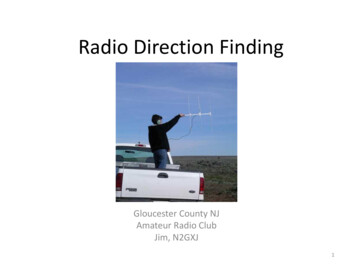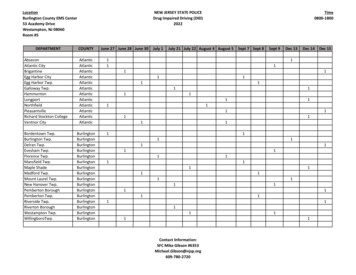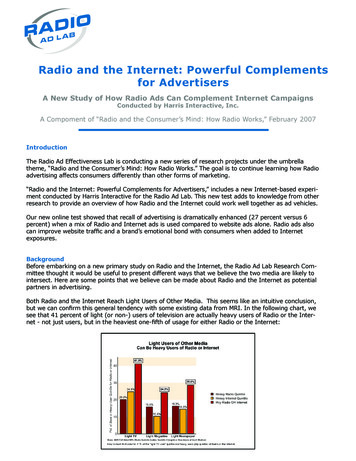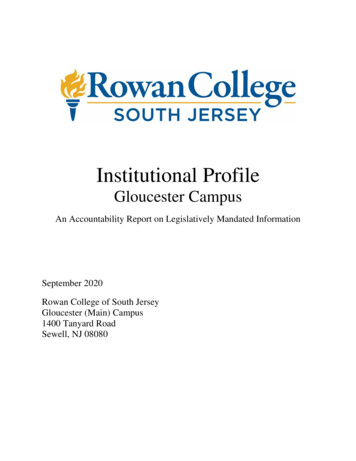
Transcription
Radio Direction FindingGloucester County NJAmateur Radio ClubJim, N2GXJ1
What is RDF? RDF – Radio Direction Finding– Determining the direction from which a receivedradio signal was transmitted. Technology has changed over the decades Essential elements of the techniques have not Success is still largely up to the skill of the RDFequipment operator2
When RDF? Searching for sources of radio interference Localizing non-authorized transmitter Identification of transmitters, known andunknown Dealing with spread spectrum techniques,especially in wireless communications Military and security forces Civilian search and rescue Wildlife tracking Radiosport!3
History DF technique is as old as radio Heinrich Hertz (1888) experiments withdecimetric waves found antenna directivity Early patents– Stone, 1902– Forest, 1909– Belini and Tosi, 1909– Adcock, 19194
History -WWI DF widely used to pinpoint enemyforces during WWI “Radio Compass”, prototype forU.S. Navy 1916 Passive technology, listen in onlarge military forces keeping incontact with their headquarters Manual RDF techniques– Rotatable antennas RF propagation challengesKensington Maryland field station, circa 1919,NIST Photographic CollectionGroundwave, skywave, multi-path,fading, polarization changes, nonwhite external noise, seasonal andtime-varying ionospherics,(don’t we df.html)5
History - WWII Accuracy improvement – HF/DF Nets– Multiple RDF stations operating together as a “net”– Each try get directional fix on callsign heard, noting time andfrequency, then coordinate with others– Intercept lines drawn on map for all sites that got a fix on targetRef: http://www.researcheratlarge.com/Pacific/RDF/6
WWII, RDF Stories Pearl Harbor– As shown in movie “Tora Tora Tora”, Japan fleet used Honolulubroadcast station as an over-the-horizon beacon for attack onPearl Harbor– Regular Japanese carrier radio operators kept back in Tokyo,generating false traffic U.S. Navy DAQ (WWII) their unique styles recognized and located as being in home islandsSecret Transmitters– British Radio Security Service – up to 1700 volunteer interceptors(radio amateurs) recruited to detect illicit transmissions– Similar efforts in Europe by the Germans to locate resistancegroups D-day Deceptions– Operation Fortitude, with (fake) First US Army Group, led byGeorge Patton. Radio trickery helped convince Germans real planfor invasion in Calais, not Normandy.German EP2a U-boats– U-boat “loop” antenna technology, used in hunting Allied shipping(ref: http://uboat.net/articles/51.html)– British ships outfitted with new automatic “HuffDuff” veryeffective in tracking and hunting short duration Germansubmarine transmissions, helped turn the tide of shipping lossesGerman U-67 DF Antenna7
Cold War After WWII– From 1950’s, US adapted German Wullenweber antenna systems for use inVietnam, cold-war eavesdropping (FRD-10, AN/FLR-9)– Russians deployed similar (Krug), early use included tracking Sputnik– OUTBOARD HF/DF systems standardized on U.S. Navy vessels New and Improved Technologies– Automatic signal search and analysis– Combined active/passive systems (e.g. Over the horizon HF radar)Refs: ng-equipmentAN/FLR-9, ref: -was-won8
Modern Era Military (still)Search and RescueWildlife TrackingSpectrum enforcementAmateur RDF9
Search and Rescue Distress Radio Beacons – Maritime (EPIRBs)– Aircraft (ELTs)– Personal (PLBs) What about APRS?– Has distress packet type, but notguaranteed & not satellitecompatibleCospas-Sarsat (satellite) compatiblebeacon frequencies– 406.025 Mhz (digital burst, satellite)– 121.5 MHz (analog, short range homer)– 243. Mhz (old, phased out since 2009) Other systems, not so standard– 457 kHz, Avalanche transceiver– 216-217 MHz, LoJack ‘Safetynet’ & lawenforcement tracking devices10
Wildlife Tracking Tracking– Micro-transmitters, collars, tagging technologies– RDF techniques (fixed-wing, mobile, and on-foot) Studies– Migration patterns– Population studies Volunteer opportunities?11
Technologies Spectrum Enforcement– If can’t ID interfering signal by demodulation, orsignal analysis, need radiolocation to locate source Radiolocation Technologies– Manual Techniques– Doppler DF– Watson-Watt– Time difference of arrival, SRDF12
Technology Manual Techniques– Use of receiver and hand-held directionalantenna– Antenna is moved/rotated to finddirections of min and max signal strength,usually based on signal amplitude– “Home-in” on signal by moving indirection of signal, then sweep to testpossible locations in suspect area– Can also plot bearing lines to triangulategeneral transmitter location– Limitations: highly dependent on skill ofoperator, accuracy poor at distance,difficult to get bearing on short durationsignals, difficult to get bearing onfrequency agile signalsRohde & Schwarz portablemonitoring & RDF13
Homing-in by Bearing If mobile, can take bearing, follow it for a bit, then repeat Not always shortest path14
Triangulation Narrow search area by triangulating lines of bearing––––Take directional measurements from several locationsPlot bearings on a map, narrow search to where bearings intersectDirectional uncertainty at distance, progressively smaller hunt areasMax signal strength (S-meter) when close, attenuate to avoid overload15
Watson-Watt Amplitude comparisontechnique, developed afterWWII, using crossed loop,or Adcock antennas Enabled real-time RDF, evenfor short duration signals Difference signals from N-S,and W-E used to deflectelectron beam on CRT Basic Adcock/Watson-Wattdesign is basis of manysystems today16
TDOA Time difference of arrival (TDOA) Works on detecting a phase difference, not amplitude difference– Useful for close-in work, when amplitude schemes overload FM tone when signal not arriving at antennas at same time– Turn antenna unit until find null (180 degree ambiguity)17
Doppler DF Doppler shift––––Circular array, electrically rotating antenna (goniometer, CDAA)Single receiver, rotational FM tone demodulatedCloser to signal: frequency shifts up, away: shift downPhase offset of recovered tone vs. original is direction of arrival18
Correlation Interferometer RDF Interferometry first used in radio astronomyMeasures angle of incident wavefront at multiple elementsRelies on digital signal processing for sensor array processingElectrically small active or passive elements, wideband performanceNumber of elements in CI antenna varies (5-9 typical)19
TDOA / Super-resolution / SRDF Taking advantage of software - digital signal processing techniques–––––––Since 1990’s, order of magnitude increase in resolutionIncreased DF accuracyAzimuth and elevation DFSimultaneous DF of multiple co-channel signalsOperation with very few data samples (MUSIC, Capon, ESPRIT algorithms)Adaptive beam forming for signal separation (null steering)Not fixed to a particular array geometry (array manfold from storedcalibration function)20
Digital receivers Near instantaneous signal acquisitionNo calibration requiredNo need for multiple coherent local oscillatorsSupports DF on short duration / frequency hopping signalsSupports reconstruction of frequency hoppersBroadband beam forming without need forlarge coaxial cable delay linesN channels provides 10logN dynamic range enhancementRef: http://www.g4axx.com/HF Radio Direction Finding.pdf21
Digital Beam forming You might have digital beam forming equipment in yourhome or office right now! 802.11n WI-FI since 2009 (e.g. Cisco Aironet, Ruckus 7962)– Adaptive antenna technology– Null steering for automatic interference mitigation22
Amateur RDF Locating sources of Interference– Unintentional– Malicious Help in Emergencies– Radiolocation, search and rescue Radiosport!– Amateur Radio Direction Finding (IARU)– T-Hunting23
ARDF - On-Foot Hunt Amateur Radio Direction Finding (ARDF)On-foot, several KM, running through the woods to finish in lowest timeCombines orienteering (compass/map) skills, with radio DF skillsInternational rules, national and international competitionsGreat web site for ARDF: www.homingin.com Just want to see what Orienteering is about? Is great Fun for the Fall!The best, and local: Delaware Valley Orienteering Association– Walking beginner courses: http://www.dvoa.org/24
Mobile T-Hunt Transmitter Hunting (T-Hunt, fox hunt)– Take place in larger geographic area than ARDF events Southern California variants– Shortest time or lowest mileage– Individual or cooperative team– Fixed or mobile transmitter25
Let’s Have Some Fun!Practice RDF skills while having fun! GCARC Mobile T-hunt!– Driving, Navigating, RDF activity, all in one– This Sunday Aug 5, 1-3pm– Team check-in on our 2M repeater(147.180 , PL 131.8)– Fox ID, then he’ll QSY to simplex(147.54 vs. 146.565) Meet-up after for socializing: Whitman Diner26
Boundaries Central Gloucester County– Fox will park in publicly accessible place (no private property)– Twice per minute transmissions (minimum), on simplex frequency usinghis own ID, clearly identifying self as the “hidden transmitter”– Hunters leave simplex frequency open for Fox transmissionscoordinate with each other during hunt on our 2M repeater frequency– Fox will give better clues if any teams still searching after an hour (2pm) Will talk-in any teams still searching after an hour and a half (2:30pm)27
T-hunt Techniques Homing-in– Directional antenna or technique (e.g. body fade)– S-meter, signal strength indication (peak or null) The stronger the signal, the closer you are!– Map of area, with plastic cover can write-on And marker, straight edge, and maybe a compass– Recommend driver independent from navigator, radiooperator (less driving distraction) Fun with partners Don’t all have to be hams!– Maybe copy of your ham license (just in case) Practice ahead of time– Talk with other club members– Can triangulate on W2MMD, other known repeaters28
Body Fade Simple technique, using your hand-held (2M HT) Hold HT close to your chest or waist and use your body to block(attenuate) the signal Slowly turn around, and listen to signal (or observe your S-meter) When signal sounds the weakest, the transmitter is behind you (180degrees from direction you are facing) As you get closer to transmitter, you may not detect any changes insignal strength.– Lower HT into cardboard box or tube shielded in aluminum foil until hearnoticeable change in signal strength. Try body fade again.– Tune off frequency /-5-10 kHz to reduce receiver’s sensitivity (therebysignal strength). Try body fade again.– Tune to 3rd harmonic (if multi-band HT), and listen for lower strengthsignal there (147.54 x 3 442.62 MHz, 146.565 x 3 439.695 MHz)– Remove the antenna and perform body fade technique again(remember RX only – don’t TX!)29
Build a Simple Directional Antenna Tape Measure Beam Optimized for Radio Direction Hunting– Joe Leggio, ape bm.htm Flexible steel “tape measure” elements– Self-supporting, yet fold easy to get in-and-out of car Great front-to-back ratio ( 50 db) for hidden transmitter hunts Build using only simple hand tools (no machine shop needed)30
Hunt Techniques Starting–––––Consider start on higher groundCheck-in with hunt coordinator on 2M repeater before start (1PM)Get initial bearing line on target, once Fox revealedAgree on plan of attackNavigate for triangulation Close-in– Stop often to get updated bearings to Fox transmissions– Narrow target area through triangulation– Front-end overload, use attenuation Off-frequency tuning ( /- 5-10kHz)3rd harmonics (147.54 MHz x 3 )Foil cardboard tube wrap (don’t short out battery terminals!)Remove the antenna all the above– Body-fade for null Find the transmitter, and you’ve found the Fox!31
Techniques Finish– “Amazing race” style in-person finish face-to-face with Fox operator get handshake and your finish order confirmation– Clear area for other hunters– If teams still hunting after first hour, Fox givesbetter and better clues as approach hard stoptime (3pm)– Fox declares hunt over when all teams havechecked-in at finish(or given up, with confirmation from the Fox)32
Foxhunt Too easy, too fast a finish?– If first team to fox in under 30 minutes, drive out tobecome 2nd Fox (146.565) Future T-hunts/foxhunts?– Let’s see how this one goes first!Possibilities . Portable ARDF transmitters (CW ID, up to 5, in-order)? Coordinated event with other area clubs? Sources for additional information– ARRL, QST Magazine(online links http://www.arrl.org/direction-finding)– CQ Magazine Questions?33
Radio Direction Finding Thank you! See you Sunday!34
-Maritime (EPIRBs) -Aircraft (ELTs) -Personal (PLBs) What about APRS? -Has distress packet type, but not guaranteed & not satellite compatible 10 Cospas-Sarsat (satellite) compatible beacon frequencies - 406.025 Mhz (digital burst, satellite) - 121.5 MHz (analog, short range homer) - 243. Mhz (old, phased out since 2009)










